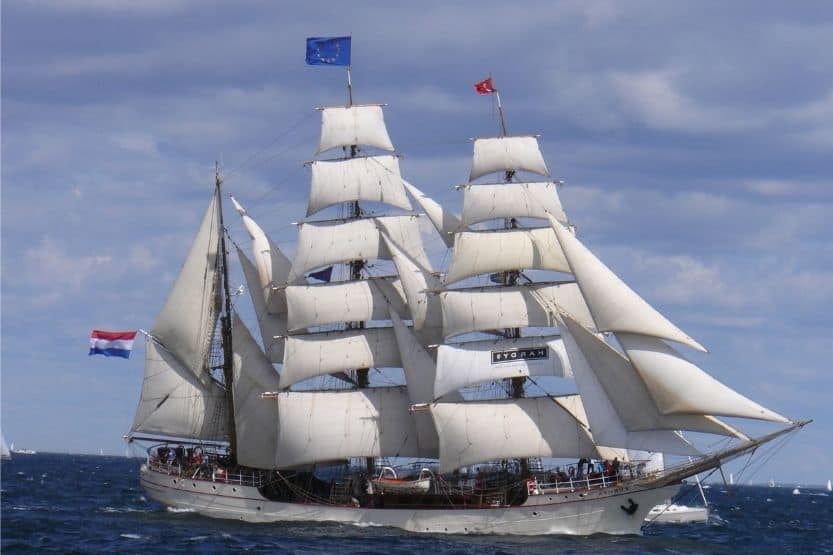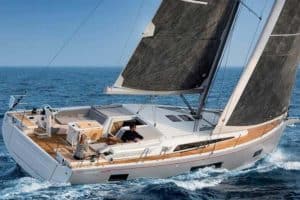Sailing ships differ in shapes, sizes, masts, and sails. In the past and up to the present, there have been a wide variety of different designs meant for different uses. What are the different types of sailing ships?
15 different types of sailing ships are as follows:
- Windjammer
- Ketch
- Yawl
- Cutter
- Fluyt
- Xebec
- Bark or Barque
- Brigantine
- Brig
- Hulk
- Fully Rigged
- Barquentine
- Clipper
- Schooner
- Carrack
Read on to learn more about these sailing ships, including their features and uses. We will also briefly discuss different types of sailboats based on their hull.
Types of Sailing Ships

Below is a detailed list of 15 sailing ships – some past and some present:
1. Windjammer
The Windjammer was a type of commercial sailing ship that was popular between the 19th and 20th centuries. It featured multiple masts that may be fore-and-aft rigged or square-rigged — or even a combination of both.
Sailors use this vessel to ferry bulk cargo such as lumber and guano. It even had an extended hull to create larger storage space.
Amid its popularity, there were environmental concerns involving the Windjammer. Furthermore, increasing fuel costs had become an issue as well. These occurrences rendered this sailing ship obsolete. Soon thereafter, ships that purely ran on wind energy were launched.
2. Ketch
A Ketch was a sailing ship with two masts. Its mainmast was noticeably taller than the other mast, known as the aft-mast or the mizzen mast. The mizzen mast was fastened on the taller mainmast to aid the vessel in maneuvering.
Famous in the 1600s in New England, the Ketch was referred to as a small coastal craft because it weighed between 100 and 250 tons only. It, however, became obsolete in the 1700s and was replaced by the schooner.
3. Yawl
This sailing ship resembled the appearance of the Ketch. The Yawl was a Dutch ship, and sailors also refer to this as Jol or Dandy. It featured a fore-and-aft sail and a couple of fully-equipped masts.
This also featured a mizzen sail designed to aid the ship in balancing and trim on rough waters.
At times, the term Yawl is applied to a light fishing vessel rigged with lugsails. Other times, it is applied to a dinghy.
4. Cutter
In the 18th century, the preferred naval ship was the Cutter. It featured a decked sail craft, several headsails, a gaff-rigged bowsprit, and a couple of masts. Its main purpose was to ferry government officials and soldiers as it was a fast sailing ship. It was capable of outrunning any enemy.
There are what we call the modern-day Cutters. This version has a rugged appearance and features fore-and-aft rigs. It is still known as one of the best sailing ships in terms of speed and agility. Thus, its tiny appearance.
Up until now, the British Sailing Club has open-oared Cutters in its vast fleet of sailing ships.
5. Fluyt
The Fluyt was a Dutch merchant sailing ship that featured three square-rigged masts. It was popular between the 16th and 17th centuries. Moreover, it featured a tiny stern, was lightly fortified, and had an extended box-style structure.
A remarkable cargoship during its time, it was also known as the Fluit or the Fleet. It had ample storage space and merely required a small crew to operate it.
Specialized tools were used to craft the Fluyt. This was mainly because the manufacturers wanted to minimize production costs to make them affordable to merchants.
6. Xebec
The Xebec sailing ship was crafted, bearing quite several impressive features. It had large lateen yards, narrow, elongated hulls, and long-prow bulkheads. It had several lateen-pillared masts and an aft-set mizzen mast wherein both raked forward and had one triangular sail.
This sailing ship was also known as Zebec. In Arabic, it means a small ship. It was known for its agility, which made it popular among the European navies. It served its purpose well. That’s why the bulk of the Meditteranean Navy fleet included the Xebec.
One Xebec was capable of carrying 36 guns on the top deck. It was a highly reliable ship for commercial cruises and anti-piracy raids. As years passed, its features evolved, including the emergence of the Polacre-Xebec that replaced the mizzen mast.
7. Bark or Barque

Next on our list of various sailing ship types include the Bark (also known as the Barque or Barc). This is different from the Schooner Bark. This sailing ship has at least three masts with mizzen rigged fore and aft and the fore- and mainmasts rigged square.
At times, the mizzen merely featured partly fore-and-aft rigged, having a square-rigged sail above.
This was popular among traders that carried huge volumes of cargo from Australia and delivered all the way to Europe. And in most cases, the cargo included Guano and Nitrates intended for the Western South American coast.
The Barque is the oldest sailing ship worldwide and was popular even before World War II started. Steam-dust winches were fitted in it in the long run to operate it even a small crew.
8. Brigantine
The Royal Navy crafted several Brigantine ships to monitor and scout for enemies while on the high seas. Oftentimes, they plied across the trade routes of Northern Europe and the Baltics as they went all the way to Scandinavia from Germany.
The Brigantine had top-gallant sails. It was considered a mid-size ship that featured a couple of sails on the mainmast and a stripped-down fully-squared rig. Its foremast featured square sails, while the mainmast featured fore-and-aft mainsail. A small crew was enough to handle it.
Click here to see this Viajero 12X50 Monocular Telescope on Amazon.
9. Brig
This sailing ship also featured top-gallant sails and, thus, was quite similar to the Brigantine. The Brig featured a couple of masts with square sails. In fact, several Brig models even had a spanker on their aft mast.
Used as a war vessel, the Brig had a berthing deck featuring sleeping quarters for marine officials and cabin crew. Furthermore, it had carronades, guns, a wood-paneled stove room, a sail bin, and storage areas.
A small crew can handle different sailing ships, except for the Brig, mainly because of its square-rigged nature. Even without tugs, it could be brought into the harbor. Furthermore, it could efficiently maneuver even in small areas.
It had the capability to follow the direction of prevailing winds flawlessly. That’s why aside from being a war vessel, it was later used for ferrying large volumes of cargo on the open seas.
10. Hulk
The Hulk was a ship incapable of going to sea. It was named since its rigging or internal equipment was removed, but its buoyant qualities were retained.
Hulks had a variety of interesting uses, which included housing, gambling sites, and prisons. In the past, they also utilize the Hulk as salvage pontoons, cargo storage, or even a naval training area.
When sailing ships become uneconomical to operate or obsolete, people turn them into hulk ships.
11. Fully Rigged
The Fully Rigged ship was popular between the 18th and 19th centuries. Commonly known as the Ship, it featured a full nautical rig bearing at least three square-shaped masts with square sails. Due to its fully rigged construction, this type of vessel was handled by a large crew.
Towards the latter part of the 19th century, the Fully Rigged ship’s newer version had trimmed down features. This was to make it possible for a smaller crew to handle it, specifically during the Monsoon period.
People refer to fully Rigged ships as Frigate ships due to their fully rigged nature. This vessel was a well-known intercontinental trading ship. Its yards, mast, hull, and rig were all made of steel or iron.
Unlike other sailing ships with specific functions and purposes, the Fully Rigged ships had varying functions and sailing plans.
12. Barquentine
The Barquentine or Schooner Barque is a sailing ship featuring at least three masts. It had a fore-and-aft rigged mainmast, a square-rigged foremast, a mizzenmast, and other masts.
With the Barquentine, the foremast was the only one square-rigged. Unlike the Fully Rigged ship, wherein all masts were square-rigged. It differed from the Barque as well, which had square-rigged fore- and mainmast.
Popular in the 17th century, the Barquentine derived its name from the Barque and the Brigantine.
13. Clipper
Another one of the most well-known sailing ship types is the Clipper. The Clipper was a merchant sailing ship launched in the 19th century. It had a narrow length and had a limited capacity to carry bulk freight. Nonetheless, the Clipper is famous for its remarkable speed.
Experts say that most Clippers were from the American and British shipyards. However, there were also those manufactured in other nations such as the Netherlands, Brazil, and France.
In 1843, sailors used Clippers to deliver tea from China to different parts of the world. Then, gold was discovered in Australia and California between 1848 and 1851. This led to the increased demand for the Clippers.
14. Schooner

The Schooner could have been launched in the 1600s, though it’s not clearly known when it was specifically launched. However, there were illustrations of the Schooner in Amsterdam as early as 1627.
This sailing ship has the rig as its defining feature. The rig features fore-and-aft rigged on all its masts. Its foremast was generally shorter than its mainmast. Schooners featured two to three masts during the 19th century.
However, the people launched Thomas W Lawson Schooner that has seven masts and interchangeable gear and sails. It was the only Schooner with seven masts.
15. Carrack
The Carrack was a nautically rigged ship popular between the 4th and 15th centuries. It was the largest vessel in Europe. In fact, the Spanish Carrack weighed over a thousand tons. It featured three to four masts with square sails.
The first versions of the Carrack featured a strange shape, making it difficult to sail when close to the wind. Experts conducted different engineering experiments through the years, including stripping off some of the Carrack’s parts to make way for a low bow and high stern.
The latest versions of the Carrack featured square-rigged mainmast and foremast. At the same time, its mizzen mast was latten-rigged. Its stern had a round shape, large bowsprit, aft castle, and forecastle.
Its main use was to ferry heavy freight intended for long-distance hauls. The Carrack was such a reliable ship even during the worst weather.
People refer to Carrack as the Great Ship. It was a name coined by the British Army due to its excellent structural design.
We’ve looked at 15 different sailing ship types; next, let’s look at types of sailboats based on the type of hull.
Click here to see this Garmin 010-01550-00 Striker 4 with Transducer on Amazon.
Types of Sailboats Based on Hull
If we talk about the sailboat’s primary hull design, then we can classify them into three. These include the following:
- Monohulls
- Catamarans
- Multi-Hull Crafts
1. Monohulls
Sailors refer to monohulls as conventional vessels. Moreover, they feature a single hull and a huge hull beam that provides sailing stability. A single large hull and its long beam result in an improved onboard system.
2. Catamarans
Catamarans are those with dual hull structures. The term catamaran was derived from a South Indian phrase that translates to “tied pieces of wood.” Tying pieces of wood were how traditional boats were crafted on the subcontinent.
3. Multi-Hull Crafts
Multi-hull crafts are vessels featuring at least three hulls. Also known as trimarans, they are exceedingly stable due to their huge beam and low center of gravity.
Click here to see this EVERSPROUT Telescoping Boat Hook on Amazon.
Conclusion – Types of Sailing Ships
There are several types of sailing ships. 15 well-known sailing ships are as follows:
- Windjammer
- Ketch
- Yawl
- Cutter
- Fluyt
- Xebec
- Bark or Barque
- Brigantine
- Brig
- Hulk
- Fully Rigged
- Barquentine
- Clipper
- Schooner
- Carrack
Most, if not all, of these, may not exist in this day and age anymore. However, they all served their purpose well. They all remarkably traversed the oceans throughout world history.
Related reading:
Types of Ships – Full List of 11 Different Types







![Read more about the article 59 Sailing Terms [Basic and Funny Terms]](https://boatinggeeks.com/wp-content/uploads/2020/12/sailing-terms-300x200.jpg)
